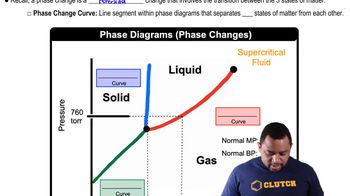A sample of steam with a mass of 0.552 g and at a temperature of 100 °C condenses into an insulated container holding 4.25 g of water at 5.0 °C. Assuming that no heat is lost to the surroundings, what is the final temperature of the mixture?
Ch.12 - Liquids, Solids & Intermolecular Forces
Chapter 12, Problem 101a
Based on the phase diagram of CO2 shown in Figure 11.39(b), describe the state changes that occur when the temperature of CO2 is increased from 190 K to 350 K at a constant pressure of (a) 1 atm
 Verified step by step guidance
Verified step by step guidance1
Identify the initial state of CO<sub>2</sub> at 190 K and 1 atm using the phase diagram.
Determine the phase boundary that CO<sub>2</sub> will cross first as the temperature increases from 190 K to 350 K at 1 atm.
Describe the state change that occurs when CO<sub>2</sub> crosses the first phase boundary (e.g., solid to gas).
Continue to increase the temperature and identify any additional phase boundaries crossed until reaching 350 K.
Describe any further state changes that occur as CO<sub>2</sub> crosses these additional phase boundaries.

Verified Solution
Video duration:
3mWas this helpful?
Key Concepts
Here are the essential concepts you must grasp in order to answer the question correctly.
Phase Diagram
A phase diagram is a graphical representation that shows the states of a substance (solid, liquid, gas) at various temperatures and pressures. It helps visualize the conditions under which a substance exists in different phases and the transitions between these phases, such as melting, boiling, and sublimation.
Recommended video:
Guided course

Phase Changes in Diagrams
State Changes
State changes refer to the transitions between different phases of matter, which occur due to changes in temperature and pressure. For CO2, these changes include sublimation (solid to gas), melting (solid to liquid), and vaporization (liquid to gas). Understanding these transitions is crucial for predicting the behavior of CO2 under varying conditions.
Recommended video:
Guided course

Physical Changes
Critical Point
The critical point is the temperature and pressure at which the distinction between liquid and gas phases disappears. Beyond this point, the substance becomes a supercritical fluid, exhibiting properties of both gas and liquid. For CO2, knowing the critical point is essential for understanding its behavior at high temperatures and pressures.
Recommended video:
Guided course

Boiling Point Elevation
Related Practice
Textbook Question
1892
views
Textbook Question
Air conditioners not only cool air, but dry it as well. A room in a home measures 6.0 m × 10.0 m × 2.2 m. If the outdoor temperature is 30 °C and the partial pressure of water in the air is 85% of the vapor pressure of water at this temperature, what mass of water must be removed from the air each time the volume of air in the room is cycled through the air conditioner? (Assume that all of the water must be removed from the air.) The vapor pressure for water at 30 °C is 31.8 torr.
997
views
3
rank
Textbook Question
A sealed flask contains 0.55 g of water at 28 °C. The vapor pressure of water at this temperature is 28.35 mmHg. What is the minimum volume of the flask in order that no liquid water be present in the flask?
1268
views
